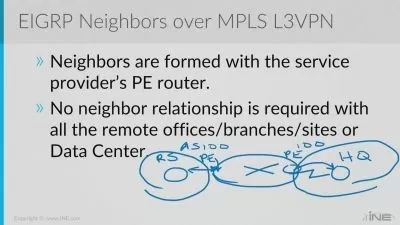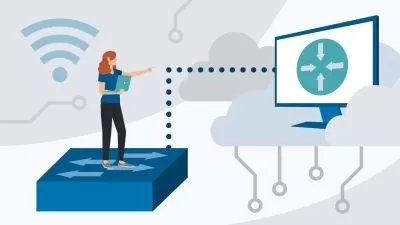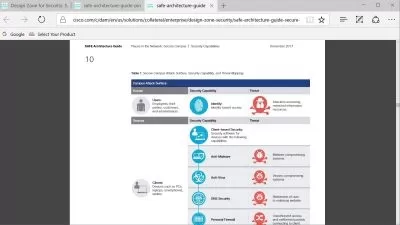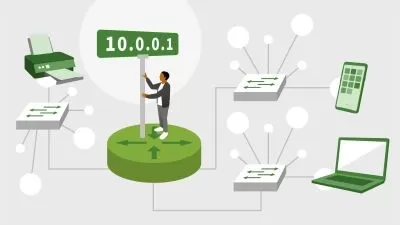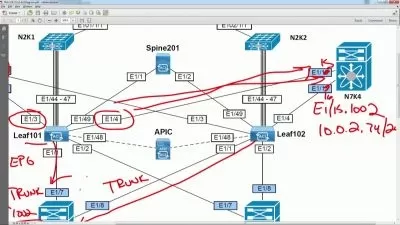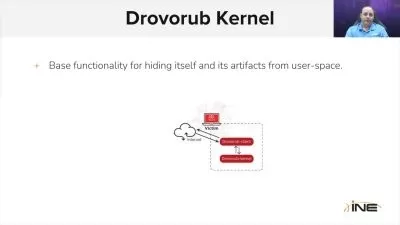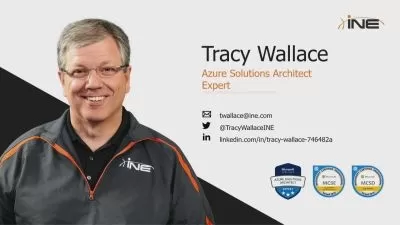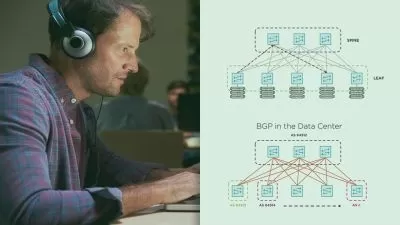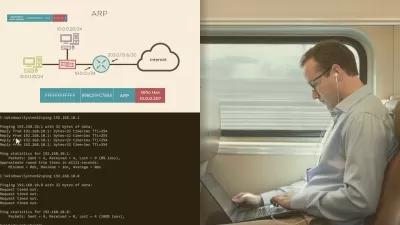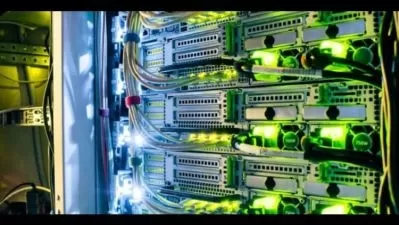A Complete VXLAN BGP EVPN Guide
Ratnesh K - 45,000+ Students Worldwide
5:50:16
Description
Step by Step VXLAN EVPN Guide
What You'll Learn?
- Implement routing and switching protocols in Data Center environment
- Implement overlay networks in data center
- Implement BGP EVPN features in data center
- Implement VXLAN in Nexus Switches
- Implement VXLAN in Catalyast Switches
- Implement Multisite via NDFC
Who is this for?
What You Need to Know?
More details
DescriptionStep by Step VXLANÂ EVPNÂ BGPÂ guide contains these 3 Section:-
Section 01:-
VXLAN is essentially an overlay that transports Layer 2 frames across a Layer 3 IP Network. It provides the ability to scale a Layer 2 broadcast domain at a larger scale while utilizing the full bandwidth of the network without blocking ports due to spanning-tree. It provides the following advantages • Uses a Layer 3 network to tranfer Layer 2 frames • Allows for ECMP through the Spine Switches • Limits spanning-tree to the host facing Leaf switch ports • Uses BGP to transfer the Layer 2 reachability information • Provides Multi-tenancy to have different customer networks reside in the same fabric
Section 02:Â
Customers are looking more and more to network fabrics to offer them simplicity in design and operation. By creating network segments, logical networks can be built independent and without the constraint of the physical topology and addressing, offering additional flexibility in design.
These fabric-based architectures are ideal for offering a balance of optimal routing and forwarding performance, while also allowing for security and policy to be integrated as fundamental aspects of the design.
BGP EVPN VXLAN is a popular standard networking technology that combines the Border Gateway Protocol (BGP) and Ethernet Virtual Private Network (EVPN) with Virtual Extensible LAN (VXLAN) to provide scalable and efficient communication between devices in a network.
This approach lets organizations build large, flat Layer 2 networks that can span across multiple physical locations, making it easier to manage and scale their network infrastructure while better managing the concerns of legacy Spanning Tree based networks. It is designed to provide a unified overlay network solution and address the challenges and drawbacks of existing technologies.
Section 03:
Cisco rebranded Data Center Network Manager (DCNM) as Nexus Dashboard Fabric Controller (NDFC) 12.
Cisco Nexus Dashboard Fabric Controller (NDFC) offers a network management system (NMS), support for traditional or multiple-tenant LAN, and SAN fabrics on a single window. Cisco NDFC can:
Work across all Cisco Nexus and MDS switching families
Manage large numbers of devices while providing ready-to-use control, management, and automation capabilities including Virtual Extensible LAN (VXLAN) control and automation for Cisco Nexus LAN fabrics
Support automatic configuration for multi-tenant automation
Offer integrated storage visualization, provisioning, and troubleshooting
Offer intuitive, multifabric topology views for LAN fabric and storage
Integrate with Cisco UCS Director, vSphere, and OpenStack
NDFC Feature Management provides the ability to dynamically enable feature sets and scale applications. The first time that you start NDFC from Cisco Nexus Dashboard, NDFC displays the Feature Management screen. If you do not configure the installer and features at this point, NDFC Feature Management only performs backup and restore operations. To enable features later, select the Feature Management option in Settings as shown in the following image.
Who this course is for:
- Network designers
- Network administrators
- Data center engineers
- Technical solutions architects
- Cisco integrators and partners
Step by Step VXLANÂ EVPNÂ BGPÂ guide contains these 3 Section:-
Section 01:-
VXLAN is essentially an overlay that transports Layer 2 frames across a Layer 3 IP Network. It provides the ability to scale a Layer 2 broadcast domain at a larger scale while utilizing the full bandwidth of the network without blocking ports due to spanning-tree. It provides the following advantages • Uses a Layer 3 network to tranfer Layer 2 frames • Allows for ECMP through the Spine Switches • Limits spanning-tree to the host facing Leaf switch ports • Uses BGP to transfer the Layer 2 reachability information • Provides Multi-tenancy to have different customer networks reside in the same fabric
Section 02:Â
Customers are looking more and more to network fabrics to offer them simplicity in design and operation. By creating network segments, logical networks can be built independent and without the constraint of the physical topology and addressing, offering additional flexibility in design.
These fabric-based architectures are ideal for offering a balance of optimal routing and forwarding performance, while also allowing for security and policy to be integrated as fundamental aspects of the design.
BGP EVPN VXLAN is a popular standard networking technology that combines the Border Gateway Protocol (BGP) and Ethernet Virtual Private Network (EVPN) with Virtual Extensible LAN (VXLAN) to provide scalable and efficient communication between devices in a network.
This approach lets organizations build large, flat Layer 2 networks that can span across multiple physical locations, making it easier to manage and scale their network infrastructure while better managing the concerns of legacy Spanning Tree based networks. It is designed to provide a unified overlay network solution and address the challenges and drawbacks of existing technologies.
Section 03:
Cisco rebranded Data Center Network Manager (DCNM) as Nexus Dashboard Fabric Controller (NDFC) 12.
Cisco Nexus Dashboard Fabric Controller (NDFC) offers a network management system (NMS), support for traditional or multiple-tenant LAN, and SAN fabrics on a single window. Cisco NDFC can:
Work across all Cisco Nexus and MDS switching families
Manage large numbers of devices while providing ready-to-use control, management, and automation capabilities including Virtual Extensible LAN (VXLAN) control and automation for Cisco Nexus LAN fabrics
Support automatic configuration for multi-tenant automation
Offer integrated storage visualization, provisioning, and troubleshooting
Offer intuitive, multifabric topology views for LAN fabric and storage
Integrate with Cisco UCS Director, vSphere, and OpenStack
NDFC Feature Management provides the ability to dynamically enable feature sets and scale applications. The first time that you start NDFC from Cisco Nexus Dashboard, NDFC displays the Feature Management screen. If you do not configure the installer and features at this point, NDFC Feature Management only performs backup and restore operations. To enable features later, select the Feature Management option in Settings as shown in the following image.
Who this course is for:
- Network designers
- Network administrators
- Data center engineers
- Technical solutions architects
- Cisco integrators and partners
User Reviews
Rating
Ratnesh K - 45,000+ Students Worldwide
Instructor's Courses
Udemy
View courses Udemy- language english
- Training sessions 37
- duration 5:50:16
- Release Date 2023/12/12






